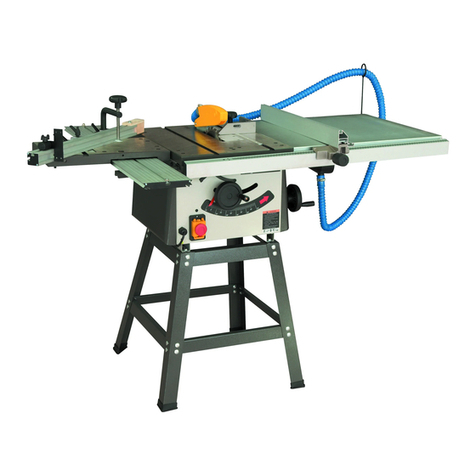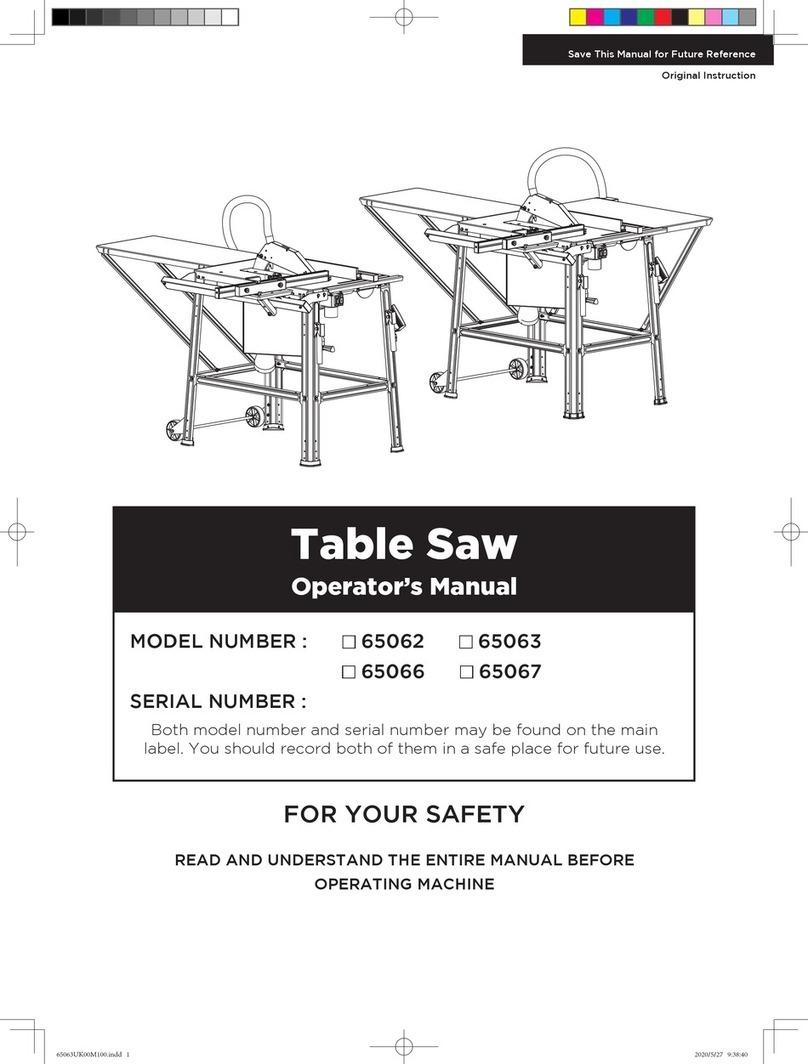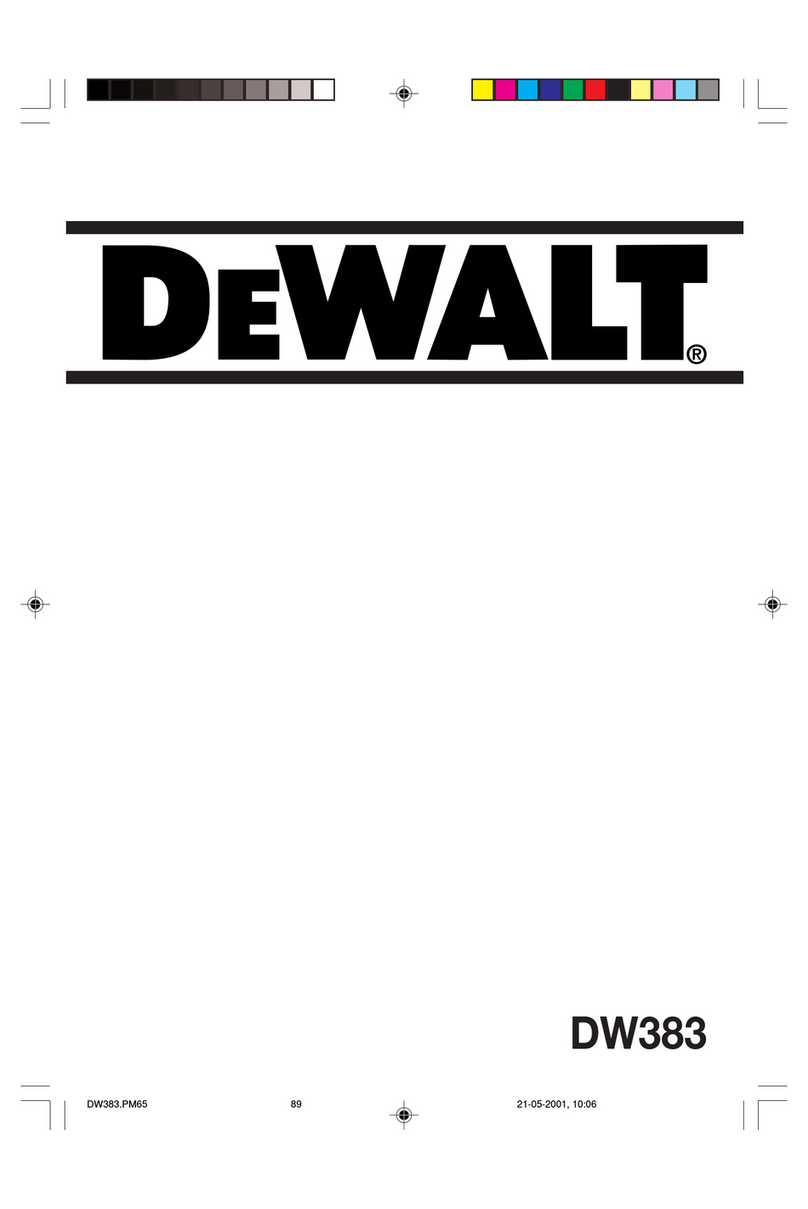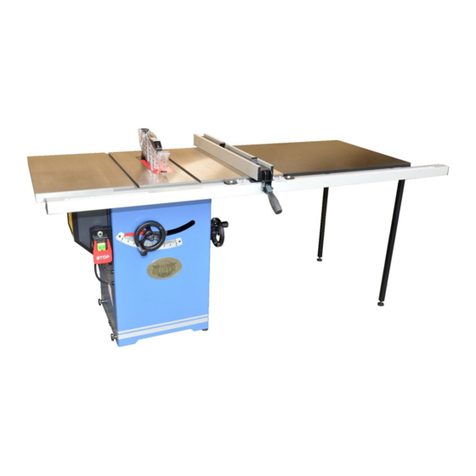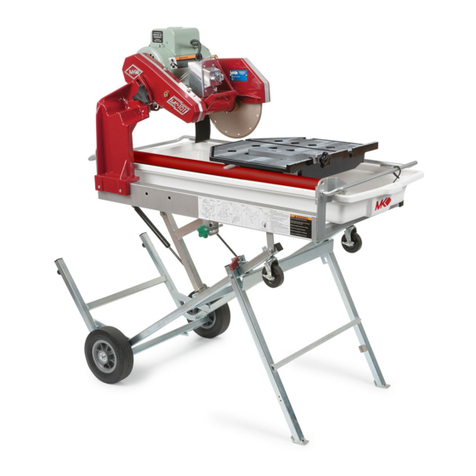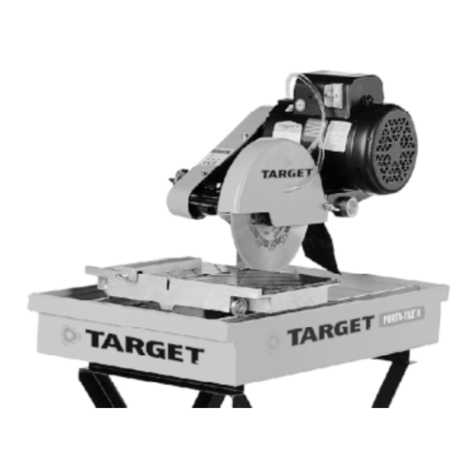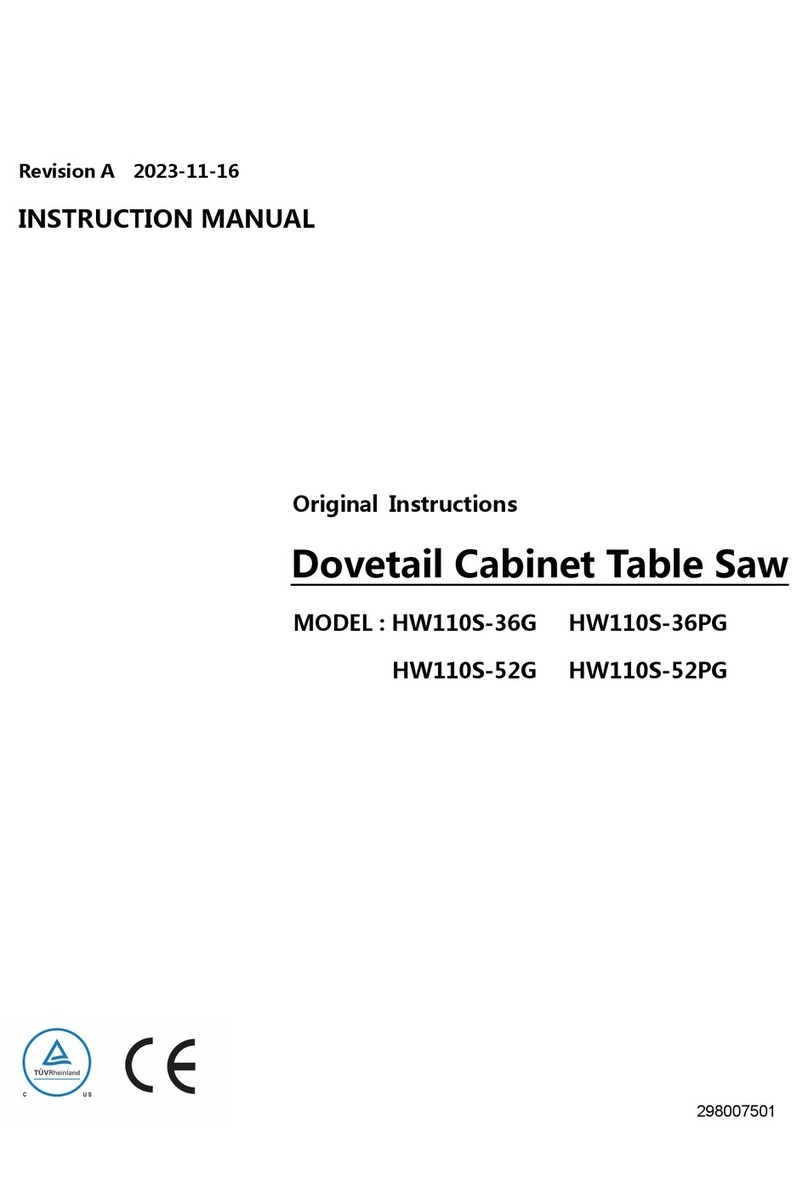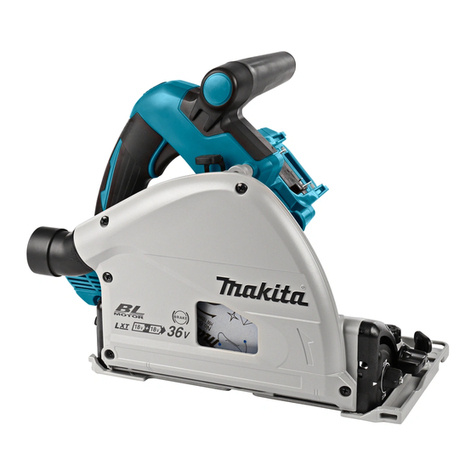TOPMAQ 65160 User manual

Save This Manual for Future Reference
Original Instructions
Band Saw
Operator’s Manual
MODEL NUMBER : 65160 65160A
SERIAL NUMBER :
Both model number and serial number may be found on the main
label. You should record both of them in a safe place for future use.
FOR YOUR SAFETY
READ AND UNDERSTAND THE ENTIRE MANUAL BEFORE
OPERATING MACHINE

BAND SAW
2
GB TABLE OF CONTENTS
INTRODUCTION
Introduction 2
Specifications 2
Symbols 3
Safety 3
Specific Safety Rules 4
Contents Supplied 7
Assembly 8
Know your Machine 9
Features & Controls 9
Set Up 11
Operation 12
Maintenance 14
Transport 18
Storage 18
Wiring Diagram 18
Trouble Shooting 19
Parts Schedule 20
Parts List 21
Your new band saw will more than satisfy your
expectations. It has been manufactured under
stringent quality standards to meet superior
performance criteria. You will find it easy and
safe to operate, and with proper care, it will
give you many years of dependable service.
Carefully read through this entire
operator’s manual before using your
new band saw. Take special care to
heed the cautions and warnings.
Specifications
Model Number 65160 65160A
AC Motor 230-240V 50Hz, n0
1487 min-1
Power P (S2 15min)* 250W
Lamp None 6.4V DC, 1W
Protection Category IP 20
Safety Class I
Throat Capacity
195 mm
Max. Cutting Height
80 mm @ 90°
45 mm @ 45°
Blade Wheel Dia. 205 mm
Blade Length 1400 mm
Blade Width: 3.5-12 mm
Cutting Speed 950 m/min
Table Size 302×304 mm
Table Tilt 90° - 45°
Weight 16.9 kg 17.5 kg
* S2, Short-time duty. After continuous operation of
15 minutes the machine stops until the device tem-
perature deviates by less than 2 K (2°C) from the room
temperature.
Sound pressure level (LpA) 82.6 db(A)* k=3 db(A)
Sound power level (LwA) 93.6 db(A)* k=3 db(A)
* The noise was measured according to EN 61029-2-
5:2011+A11.
This band saw is designed for operating under
ambient temperatures between +5°C and
40°C and for installation at altitudes no more
than 1000m above M.S.L. The surrounding
humidity should less than 50% at 40°C. It
can be stored or transported under ambient
temperatures between -25°C and 55°C.
APPLICATION CONDITIONS
RECYCLING AND DISPOSAL
This marking indicates that this
product should not be disposed with
other household wastes. To prevent
possible harm to the environment
or human health from uncontrolled
waste disposal, recycle it responsibly
to promote the sustainable reuse of
material resources. To return your
used device, please use the return
and collection systems or check with
your local authority or local stores
for advice of environmental safe
recycling.

BAND SAW 3
GB
SYMBOLS
The rating plate on your machine may
show symbols. These represent important
information about the product or instructions
on its use.
Read these instructions for use
carefully.
Caution! Wear ear-muffs. The
impact of noise can cause damage
to hearing.
Caution! Wear safety goggles.
Sparks generated during working
or splinters, chips and dust
emitted by the device can cause
loss of sight.
Wear protective gloves.
Caution! Wear a breathing mask.
Dust which is injurious to health
can be generated when working
on wood and other materials.
Never use the device to work on
any materials containing asbestos!
Caution! Risk of injury! Failure
to keep your hands away from
the blade will result in serious
personal injury.
The machine must be
disconnected from the supply
before maintenance! Disconnect
the mains plug prior to the repair,
cleaning, and maintenance of
the saw!
Keep children and bystanders off
and away.
SAFETY
General Safety Rules
Understand your Machine
Read this manual and labels affixed to the
machine to understand its limitations and
potential hazards.
Be thoroughly familiar with the controls and
their proper operation. Know how to stop the
machine and disengage the controls quickly.
Do not attempt to operate the machine until
you fully understand how to properly operate
and maintain the engine and how to avoid
accidental injuries and/or property damage.
If the unit is to be used by someone other than
original purchaser or loaned, rented, or sold,
always provide this manual and any needed
safety training before operation. The user can
prevent and is responsible for accidents or
injuries that may occur to themselves, other
people, and property.
Do not force the machine. Use the correct
machine for your application. The correct
machine will do the job more efficiently and
safer at the rate it was designed.
Personal Safety
warning! The use of any accessory or
attachment other than one recommended in
this instruction manual may present a risk of
personal injury.
Do not permit children to operate this machine
at any time.
Keep children, pets, and other people not
using the unit away from the work area. Be
alert and shut off unit if anyone enters work
area. Keep children under the watchful care of
a responsible adult.
Do not operate the machine while under the
influence of drugs, alcohol, or any medication
that could affect your ability to use it properly.
Dress properly. Wear heavy long pants, boots,
and gloves. Do not wear loose clothing, short
pants, or jewelry of any kind. Secure long hair
so it is above shoulder level. Keep your hair,
clothing, and gloves away from moving parts.
Loose clothes, jewelry, or long hair can be
caught in moving parts.

BAND SAW
4
GB Protect eyes, face, and head from objects that
may be thrown from the unit. Always wear
safety goggles or safety glasses with side
shields when operating.
Wear appropriate hearing protection. Wear
respiratory protection to avoid the risk of
inhaling harmful dust.
Always keep hands and feet away from all
moving parts during operation. Moving parts
can cut or crush body parts.
Always keep hands and feet away from all
pinch points.
Do not touch parts that might be hot
from operation. Allow parts to cool before
attempting to maintain, adjust, or service.
Stay alert, watch what you are doing, and use
common sense when operating the machine.
Do not overreach. Do not operate the machine
while barefoot or when wearing sandals or
similar lightweight footwear. Wear protective
footwear that will protect your feet and
improve your footing on slippery surfaces.
Keep proper footing and balance at all times.
This enables better control of the machine in
unexpected situations.
Inspect your Machine
Check your machine before starting it. Keep
guards in place and in working order. Make
sure all nuts, bolts, etc., are securely tightened.
Never operate the machine when it is in need
of repair or is in poor mechanical condition.
Replace damaged, missing, or failed parts
before using it. Keep the machine in safe
working condition. Regularly check to see that
keys and adjusting wrenches are removed
from the machine area before starting it. A
wrench or a key that is left attached to a
rotating part of the machine may result in
personal injury. Avoid accidental starting.
Be sure the motor switch is off before
transporting the machine or performing any
maintenance or service on the unit.
Transporting or performing maintenance
or service on a machine with its switch on
invites accidents. If the machine should start
to vibrate abnormally, stop the motor and
check immediately for the cause. Vibration is
generally a warning sign of trouble.
Electric Safety
Avoid use of free and inadequately insulated
connections. Connections must be made with
protected material suitable for outdoor use.
Protect yourself from electric shock. Do not
plug or unplug the motor while standing in or
around damp or wet ground. Do not use the
unit in wet or damp areas or expose it to rain.
Prevent body contact with grounded surfaces:
pipes, radiators, ranges, and refrigerator
enclosures. Make sure your fingers do not
touch the plug’s metal prongs when plugging
or unplugging the unit.
Avoid inadvertent starting. Make sure that the
switch is switched off when plugging the plug
into an outlet.
Only use approved and appropriately
identified extension cables for use outdoors.
Only use cable reels in the unrolled state.
Do not use the cable for purposes for which
it is not intended. Do not use the cable to pull
the plug out of the outlet. Protect the cable
from heat, oil and sharp edges.
Never yank the cord to disconnect it from the
socket.
Have your electric tool repaired by a qualified
electrician. This electric tool conforms to the
applicable safety regulations. Repairs may
only be performed by an electrician using
original spare parts. Otherwise accidents can
occur.
Work Area & Store Area
Keep the work area orderly. Disorder in the
work area can lead to accidents.
Take environmental influences into account.
Do not expose electric tools to rain. Do
not use electric tools in a damp or wet
environment. Make sure that the work area
is well-illuminated. Do not use electric tools
where there is a risk of fire or explosion.
Securely store unused electric tools. Unused
electric tools should be stored in a dry,
elevated or closed location out of the reach of
children.
Insure sufficient lighting in the work area and
the area around the machine.

BAND SAW 5
GB
Specific Safety Rules
Intended Use
The band saw is designed to perform
longitudinal and cross cuts on timber or
wood-type materials. To cut round materials
you must use suitable holding devices. The
equipment is to be used only for its prescribed
purpose. Any other use is deemed to be
a case of misuse. The user / operator and
not the manufacturer will be liable for any
damage or injuries of any kind caused as a
result of this. The machine is to be operated
only with suitable saw blades. To use the
machine properly you must also observe the
safety regulations, the assembly instructions
and the operating instructions to be found in
this manual. All persons who use and service
the machine have to be acquainted with
this manual and must be informed about
the machine’s potential hazards. It is also
imperative to observe the accident prevention
regulations in force in your area. The same
applies for the general rules of occupational
health and safety.
Machine Use and Care
The manufacturer shall not be liable for any
changes made to the machine nor for any
damage resulting from such changes. Even
when the machine is used as prescribed it is
still impossible to eliminate certain residual
risk factors. The following hazards may arise
in connection with the machine’s construction
and design:
● Damage to hearing if ear-muffs are not used
as necessary.
● Harmful emissions of wood dust when used
in closed rooms.
● Contact with the blade in the uncovered
cutting zone.
● Injuries (cuts) when changing the blade.
● Injury from catapulted workpieces or parts
of work-pieces.
● Crushed fingers.
● Kickback.
● Tilting of the workpiece due to inadequate
support.
● Touching the blade.
● Catapulting of pieces of timber and
workpieces.
Please note that our equipment has not been
designed for use in commercial, trade or
industrial applications. Our warranty will be
voided if the machine is used in commercial,
trade or industrial businesses or for equivalent
purposes.
Risk of kickback (workpiece is caught by
the band saw blade and thrown against the
operator)! Do not jam workpieces. Cut thin
or thin-walled workpieces only with fine-
toothed saw blades. Always use sharp band
saw blades. If in doubt, check workpiece
for inclusion of foreign matter (e.g. nails
or screws). Cut only stock of dimensions
that allow for safe and secure holding while
cutting. Never cut several workpieces at the
same time, and also no bundles containing
several individual pieces. Risk of personal
injury if individual pieces are caught by the
band saw blade uncontrolled. When cutting
round stock, use a suitable jig to prevent the
workpiece from turning.
Maintain Tools with Care
Keep cutting tools sharp and clean for better
and safer performance.
Follow instruction for lubricating and changing
accessory.
Inspect tool cords periodically and if damaged
have them repaired by an authorized service
facility.
inspect extension cords periodically and
replace if damaged.
Keep handles dry, clean and free from oil and
grease.
Maintenance and Repair
Pull out the mains plug for any adjustment or
repair tasks.
The generation of noise is influenced by
various factors, including the characteristics
of saw blades, condition of saw blade and
electric tool. Use saw blades which were
designed for reduced noise development,
insofar as possible. Maintain the electric
tool and tool attachments regularly and if
necessary, initiate repairs in order to reduce
noise.

BAND SAW
6
GB Report faults on the electric tool, protective
devices or the tool attachment to the person
responsible for safety as soon as they are
discovered.
Check the electric tool for potential damage.
Protective devices and other parts must be
care-fully inspected to ensure that they are
fault-free and function as intended prior to
continued use of the electric tool. Check
whether the moving parts function faultlessly
and do not jam or whether parts are dam-aged.
All parts must be correctly mounted and all
conditions must be fulfilled to ensure fault-
free operation of the electric tool. The moving
protective hood may not be fixed in the open
position. Damaged protective devices and
parts must be properly repaired or replaced
by a recognized workshop, insofar as nothing
different is specified in the operating manual.
Damaged switches must be replaced at a
customer service workshop. Do not use any
faulty or damaged connection cables. Do
not use any electric tool on which the switch
cannot be switched on and off.
Additional safety instructions
● Wear safety gloves whenever you carry out
any maintenance work on the blade!
● When cutting round or irregularly shaped
wood, use a device to stop the workpiece
from twisting.
● When cutting boards in upright position, use
a device to prevent kick-back.
● A dust extraction system designed for an
air velocity of 20 m/s should be connected
in order to comply with woodworking dust
emission values and to ensure reliable
operation.
● Give these safety regulations to all persons
who work on the machine.
● Do not use this saw to cut fire wood.
● The machine is equipped with a safety
switch to prevent it being switched on again
accidentally after a power failure.
● Before you use the machine for the first time,
check that the voltage marked on the rating
plate is the same as your mains voltage.
● If you use a cable reel, the complete cable
has to be pulled off the reel.
● Persons working on the machine should not
be distracted.
● Note the direction of rotation of the motor
and blade.
● Never dismantle the machine's safety
devices or put them out of operation.
● Never cut workpieces which are too small to
hold securely in your hand.
● Never remove loose splinters, chips or
jammed pieces of wood when the saw blade
is running.
● It is imperative to observe the accident
prevention regulations in force in your area
as well as all other generally recognized
rules of safety.
● Note the information published by your
professional associations.
● Adjustable protective devices have to
be adjusted as close as possible to the
workpiece.
● Important! Support long workpieces (e.g.
with a roller table) to prevent them sagging
at the end of a cut.
● Make sure the blade guard (3) is in its lower
position when the saw is being transported.
● Safety guards are not to be used to move or
misuse the machine.
● Blades that are misshapen or damaged in
any way must not be used.
● If the table insert is worn, replace it.
● Never operate the machine if either the
door protecting the blade or the detachable
safety device are open.
● Ensure that the choice of blade and the
selected speed are suitable for the material
to be cut.
● Do not begin cleaning the blade until it has
come to a complete standstill.
● For straight cuts of small workpieces against
the longitudinal limit stop the push stick has
to be used.

BAND SAW 7
GB
The band saw comes partially assembled and is shipped in carefully packed carton. After all the
parts have been removed from the carton, you should have:
CONTENTS SUPPLIED
4
1 3
2 9
5
6
7
8
11
10
9
A
B
● The band saw blade guard should be in its
lowest position close to the bench during
transport.
● For miter cuts when the table is tilted, the
parallel stop must be positioned on the
lower part of the table.
● When cutting round timber, use a suitable
holding device to prevent the workpiece
turning.
● Never use guards to lift or transport items.
● Ensure that the band saw blade guards are
used and correctly adjusted.
● Keep your hands a safety distance away
from the band saw blade. Use a push stick
for narrow cuts.
● The push stick has to be stored on the
intended device, so that it can be reached
from normal working position and is always
ready to be used.
● In the normal operating position the operator
is in front of the machine.

BAND SAW
8
GB
This band saw was partially assembled at the
factory. To assemble your machine follow the
below instructions.
Work Table
1. Remove the two screws, two knurled nuts
and U shape block from the work table.
2. Guide work table over the blade and place
it on the table trunnion. Positon the table
insert on the work table properly.
3. Attach the work table with three each
screws M6×16 to the table trunnion.
4. Fasten the work table with three nuts M6
and three fla t washers.
5. Attach two screws and two knurled nuts
with U shape block that were removed in
step one and fasten.
ASSEMBLY
1
2
3
TOP
VIEW
BOTTOM
VIEW
Work Table
Table Insert
M6 ×16 (×3)
Bench Angle Gauge
M6 Nut (×3)
NOTE: Before fastening the work
table, make sure table be aligned
in two planes. Laterally, in order
for the blade to run dead centre
through the table insert.At right
angles to the blade.
1. Main Machine
2. Push Stick
3. Work Table
4. Rip Fence
5. Table Insert
6. Operator’s Manual
7. Allen Key, 4mm
8. Allen Key, 3mm
9. Blade Key
10. Lamp
11. Hardware Bag

BAND SAW 9
GB
1
2
3
TOP
VIEW
BOTTOM
VIEW
Work Table
Table Insert
M6 ×16 (×3)
Bench Angle Gauge
M6 Nut (×3)
M6 ×16 ×3 A
Locker
Push Stick
1. Fix the screw and nuts on the machine,
leaving room for push stick.
2. Hang the push stick on the screw.
Rip Fence
Clamp the rip fence. It can be used on both
sides of blade.
Lamp
1. Plug the cable connectors together.
2. Align the holes in the unit with the holes in
the rear plate of lamp. Secure and tighten
by using one M4x16 and two M4x25 screws.
M6 ×35 (×1)
M6 Nut (×1)
M6 ×35 ×1 B
1
2
M4 ×25 (×2)
M4 ×16 (×1)
M4 ×16 ×1
B
M4 ×25 ×2
During installation do not get the
cables crushed by the screws.

BAND SAW
10
GB KNOW YOUR MACHINE
Features and Controls
Rip Fence
Setting Knob for Work Table
ON/OFF Switch
Blade
Locking Knob for Blade Guard
Lower Housing Door
Suction Connector
Upper Housing Door
Setting Knob for Blade Tension
Setting Knob for Blade Guard
Work Table
Motor
Door Lock
Door Lock
Power Cord and Plug
Push Stick
Setting Knob for Blade Tracking
Adjustment
Lamp (65160A Only)
ON/OFF Switch for Lamp

BAND SAW 11
GB
Set Up
Adjusting the Blade Tension
This tracking adjustment is required to have
the blade run dead center on the rubber tyres
of the band saw wheels:
● Turning the setting knob clockwise increases
the blade tension.
● Turning the setting knob counter- clockwise
reduces the blade tension.
Adjusting the Work Table Tilting
After loosening both locking screws, the work
table tilts steplessly through 45° to the blade.
Work Table Alignment
Saw Table Lateral Alignment
1. Loosen the three fastening screws that hold
the lower table trunnion.
2. Align working table so that the blade runs
through the centre of the table insert’s slot.
3. Tighten the three fastening screws again.
Working Table
Angle Scale
Limit Stop
Screw
Pointer
Locking Screw Min: 0°
Max: 45°
Aligning the work table at right angles to the
blade
1. Raise upper blade guide fully. Check band
saw blade tension.
Try Square

BAND SAW
12
GB Adjusting the Blade Guard
The blade guard protects against unintentional
contact with the saw blade and from chips
flying about. In order for the upper blade guard
to provide adequate protection against contact
with the band saw blade, it must always be
set as close as possible against the workpiece
(max. distance 3 mm).
1. Loosen the locking knob.
2. Rotate the setting knob to adjust the blade
guard in the right position, then fasten the
locking knob.
Setting Up the Rip Fence
The rip fence is clamped to the front. It can be
used on both sides of the blade.
2. Loosen locking screws.
3. Using a try square, set the table at right
angles to the blade and tighten the locking
screws again.
4. Loosen locking nut and adjust limit stop
screw until it touches the working table.
5. Tighten locking nut.
Work Table
Limit Stop Screw
Locking Nut
Operation
Start the saw only after the following
preparations are completed:
● The saw is fastened;
● The saw table is installed and
aligned;
●
Safety devices have been checked.
Connect the saw to the mains supply
only afterall ofthe abovepreparations
are completed! Otherwise there is
a risk of an unintentional starting
of the saw, which can cause severe
personal injury.
1
3
2
Locking Knob
3 mm
Setting
Knob

BAND SAW 13
GB
Sawing
1. If necessary, adjust the table tilt.
2. Select rip fence and table tilt for the type of
cutting operation to be carried out.
3. Set upper blade guide 3 mm above the
workpiece.
4. Place workpiece on the working table.
5. Plug in.
6. Start saw.
7. Cut workpiece in a single pass.
8. Switch off if no further cutting is to be done
immediately afterwards.
Danger by jamming workpiece!
When using the rip fence with a
tilted saw table, the rip fence must
be installed on the lower side of the
working table.
Mounting the saw in the stable and flat
supporting surface
1. Drill 4 holes in the supporting surface.
2. Put fixing bolts through the base plate and
secure with nuts.
Supporting Surface
Base Plate
305mm
305mm
220mm
220mm
M6-Bolt (×4)
Ø6.5mm
diameter
hole (×4)
ON/OFF Switch
The saw can be switched on by pressing the
green pushbutton.
The red pushbutton has to be pressed to switch
off the machine.
ON/OFF Switch for Lamp
Press "I" to turn on the lamp.
Press "O" to turn off the lamp
This light switch can only work when the ON/
OFF switch for the product is turned on.
Green “I” button
Red “O” button
Always make a trial cut in a piece
of scrap to verify settings; correct
if necessary before cutting the
workpiece.
“O”
“I”

BAND SAW
14
GB
1M6 ×16 (×2)
2
Warning! Prior to any adjustment,
maintenance or service work
disconnect the mains power plug!
Danger! Risk of injury, even with the
band saw blade at standstill. Wear
gloves when changing blades.
General Maintenance Measures
Keep all safety devices, air vents and the
motor housing free of dirt and dust as far as
possible. Wipe the equipment with a clean
cloth or blow it with compressed air at low
pressure.
We recommend that you clean the device
immediately each time you have finished using
it.
Clean the equipment regularly with a damp
cloth and some soft soap. Do not use cleaning
agents or solvents; these could attack the
plastic parts of the equipment. Ensure that no
water can seep into the device. The ingress of
water into an electric tool increases the risk of
an electric shock.
In order to extend the service life of the tool,
oil the rotary parts once monthly. Do not oil
the motor.
Use only suitable band saw blades.
1. Loosen the 2 knurled screws and remove
the U shape blocker.
2. Open both housing doors.
3. Loosen setting knob until the band saw
blade has slackened.
4. To remove the band saw blade, guide it
through the slot in the working table.
Saw Blade Change
MAINTENANCE
5. Fit fresh band saw blade. Ensure correct
position: the teeth must point towards the
front of the saw (where the doors are).
6. Center band saw blade on the rubber tyres
of the band saw wheels.
7. Tighten setting knob until blade does no
longer slip off the band saw wheels.
8. Close both housing doors.
9. Tension band saw blade;
Align band saw blade and align blade guides;
let saw test run for at least one minute;
Stop saw, unplug and recheck settings.
Machine has suction connector,
user can connect the machine to a
proper suction unit when working.

BAND SAW 15
GB
3
4
Adjusting the Blade Tension
This tracking adjustment is required to have
the blade run dead center on the rubber tyres
of the band saw wheels:
● Turning the setting knob clockwise increases
the blade tension.
● Turning the setting knob counter - clockwise
reduces the blade tension.
Band Saw Blade Alignment
If the band saw blade does not run in the centre
of the rubber tyres, the tracking needs to be
corrected by adjusting the tilt of the upper
band saw wheel:
1. Loosen locking nut.
2. Turn setting knob:
● Turn setting knob clockwise if the band saw
blade runs towards the front of the saw.
● Turn setting knob counter- clockwise if the
band saw blade runs towards the rear of the
saw.
3. Tighten locking nut.

BAND SAW
16
GB
0.5 mm 0.5 mm
1 3
2
Upper Blade Guide Alignment
The upper blade guide consists of:
● a thrust bearing (supports the band saw
blade from the rear),
● two guide pins (providing lateral support).
The bearing and guide pins need to be
readjusted after every band saw blade change
or tracking.
Lower Blade Guide Alignment
The lower blade guide consists of:
● a thrust bearing (supports the band saw
blade from the rear),
● two guide pins (providing lateral support).
Thrust bearing adjustment
1. If necessary, align and tighten the band saw
blade.
2. Loosen the thrust bearing’s locking screw.
3. Adjust thrust bearing position (distance
thrust bearing - band saw blade = 0.5 mm
- if the band saw blade is turned by hand, it
shall not touch the thrust bearing.
Guide pin adjustment
1. Loosen screws.
2. Press guide pins together, keep 0.5 mm
distance between guide pin and the saw
blade.
3. Tighten screws again.
4. Tighten the thrust bearing locking screw.
NOTE: Periodically check all bearings
for wear, if necessary replace both
guide bearings at the same time.
NOTE: Periodically check thrust
bearings and guide pins for wear, if
necessary replace both guide pins
at the same time.

BAND SAW 17
GB
0.5 mm 0.5 mm
Table Insert
Table Insert Replacement
The table insert needs replacement when its
slot has become enlarged or damaged.
1. Remove table insert from saw table (push
up from underneath).
2. Fit new table insert.
Thrust bearing adjustment
1. Loosen the two screws and remove the
under blocks.
2. Loosen the three screws and Remove the
working table from the table trunnion .
3. Loosen the two knobs and remove the
bench angle gauge.
4. Open the lower housing door.
5. Raise upper blade guide fully.
6. If necessary, align and tighten the band saw
blade.
7. Loosen the thrust bearing's locking screw.
8. Adjust thrust bearing position (distance
thrust bearing - band saw blade = 0.5 mm
- if the band saw blade is turned by hand, it
shall not touch the thrust bearing.
Guide pin adjustment
1. Loosen screws.
2. Press guide pins together, keep 0.5 mm
distance between guide pin and the saw
blade.
3. Tighten screws again.
4. Attach the working table to the table
trunnion.
5. Fit the U shape under block to the working
table.
9. Tighten the thrust bearing locking screw.
Bench Angle Gauge

BAND SAW
18
GB
WIRING DIAGRAM
65160
65170
65160A
Micro Switch
(Lower Housing Door)
Micro Switch
(Upper Housing Door)
Micro Switch
(Lower Housing Door)
Micro Switch
(Upper Housing Door)
Close-End Wire
Connector
Close-End Wire
Connector
Power Supply Cord
Motor
Motor
230-240V~ 50Hz
Close-End Wire
Connector
Power Supply Cord
230-240V~ 50Hz
Crown
Crown
Crown
Crown
BlueBlue
Blue
Close-End Wire
Connector
Crown
Crown
Crown
BlueBlue
Blue
Blue
Crown
Blue
U
<
K
c
U
<
K
c
Micro Switch
(Lower Housing Door)
Micro Switch
(Upper Housing Door)
Close-End Wire
Connector Close-End Wire
Connector
Close-End Wire
Connector
Close-End Wire
Connector
Motor
SWITCH
PCB
Lamp
Lamp
Power Supply Cord
230-240V~ 50Hz
Crown
Crown
Crown
Crown
Blue Blue
Red
Crown Blue
Blue
Blue Blue
Store the equipment and accessories in a dark
and dry place at above freezing temperature.
The ideal storage temperature is between 5
and 30°C. Store the electric tool in its original
packaging. Cover the electric tool in order to
protect it from dust and moisture.
STORAGE
1. Turn off the power tool before any transport
and disconnect it from the power supply.
2. Apply the power tool at least with two
people, do not touch the table extensions.
3. Protect the power tool from knocks, bumps
and strong vibrations such as during
transport in vehicles.
4. Secure the power tool against overturning
and sliding.
TRANSPORT 5. Never use the safety devices for handling or
transporting purpose.

BAND SAW 19
GB
TROUBLE SHOOTING
Problem Cause Remedy
Motor does not
work
1. Motor, cable or plug defective,
fuses burnt
2. Housing cover open (limit
switch)
1. Arrange for inspection of the
machine by a specialist. Never repair
the motor yourself. Danger! Check
fuses and replace as necessary
2. Close housing cover exactly
The motor starts
up slowly and does
not reach operating
speed
Voltage too low, coils damaged,
capacitor burnt
Contact the utility provider to check
the voltage
Arrange for inspection of the motor by
a specialist
Arrange for replacement of the
capacitor by a specialist
Motor makes
excessive noise Coils damaged, motor defective Arrange for inspection of the motor by
a specialist
The motor does not
reach its full power
Circuits in the network are
overloaded (lamps, other motors,
etc.)
Do not use any other equipment or
motors on the same circuit
Motor overheats
easily
Overloading of the motor,
insufficient coolinof the motor
Avoid overloading the motor while
cutting, remove dust from the motor in
order to ensure optimal cooling of the
motor
Saw cut is rough
orwavy
Saw blade dull, tooth shape
not appropriate forthe material
thickness
Resharpen saw blade and/or use
suitable saw blade
Workpiece pulls
awayand/or
splinters
Excessive cutting pressure and/
or saw bladenot suitable for use Insert suitable saw blade
Saw blade is not
running straight
1. Guide has been wrongly set
2. Wrong saw blade
1. Set the saw blade guide according
to the operating instructions
2. Select a saw blade according to the
operating instructions
Burn marks appear
on the wood during
the cutting work
1. Blunt saw blade
2. Wrong saw blade
1. Change the saw blade
2. Select a saw blade according to the
operating instructions
Saw blade jams
during cutting work
1. Blunt saw blade
2. Deposits on the saw blade
3. Guide has been set poorly
1. Change the saw blade
2. Clean the saw blade
3. Set the saw blade guide according
to the operating instructions

BAND SAW
20
GB PARTS SCHEDULE
65160A ONLY
USED
This manual suits for next models
1
Other TOPMAQ Saw manuals
Popular Saw manuals by other brands
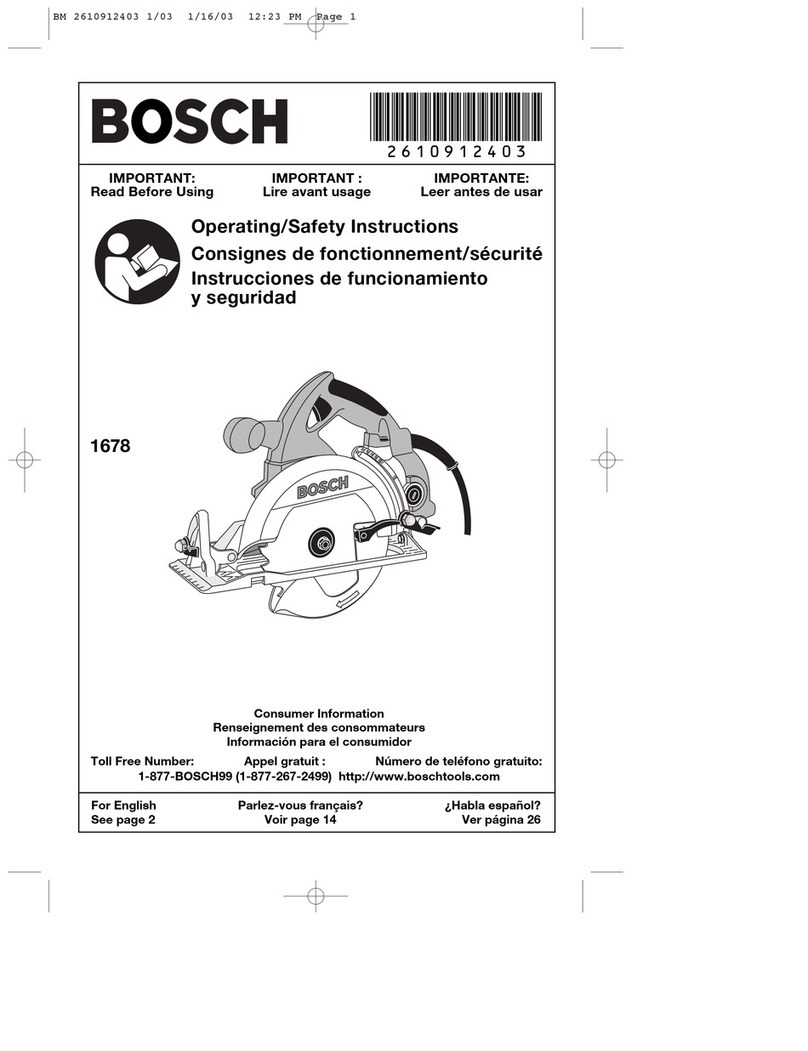
Bosch
Bosch 1678 - 7-1/4" Worm Drive Saw Operating/safety instructions
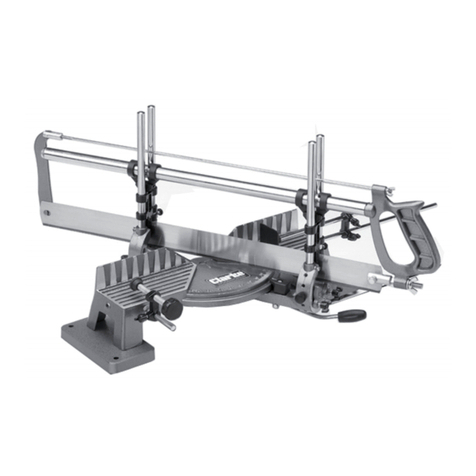
Clarke
Clarke Woodworker MBS600C Assembly instructions

Parkside
Parkside PHKS 1450 LASER Operation and safety notes
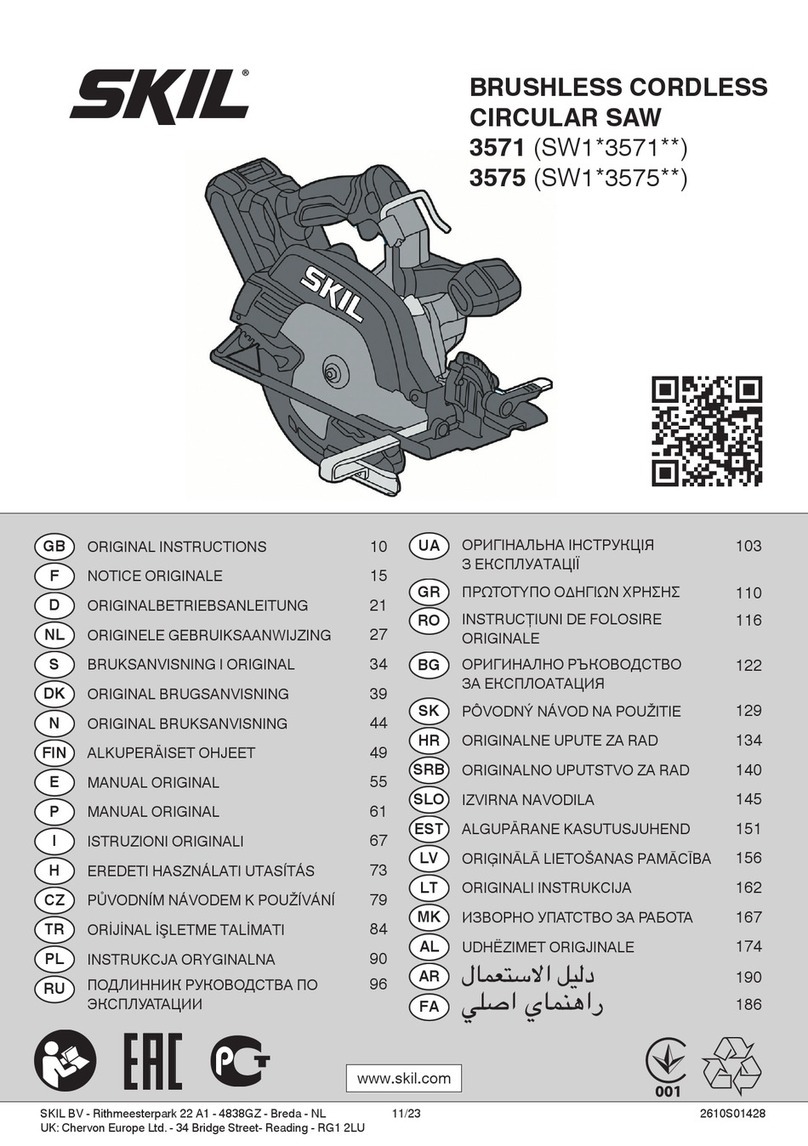
Skil
Skil 3575 Original instructions
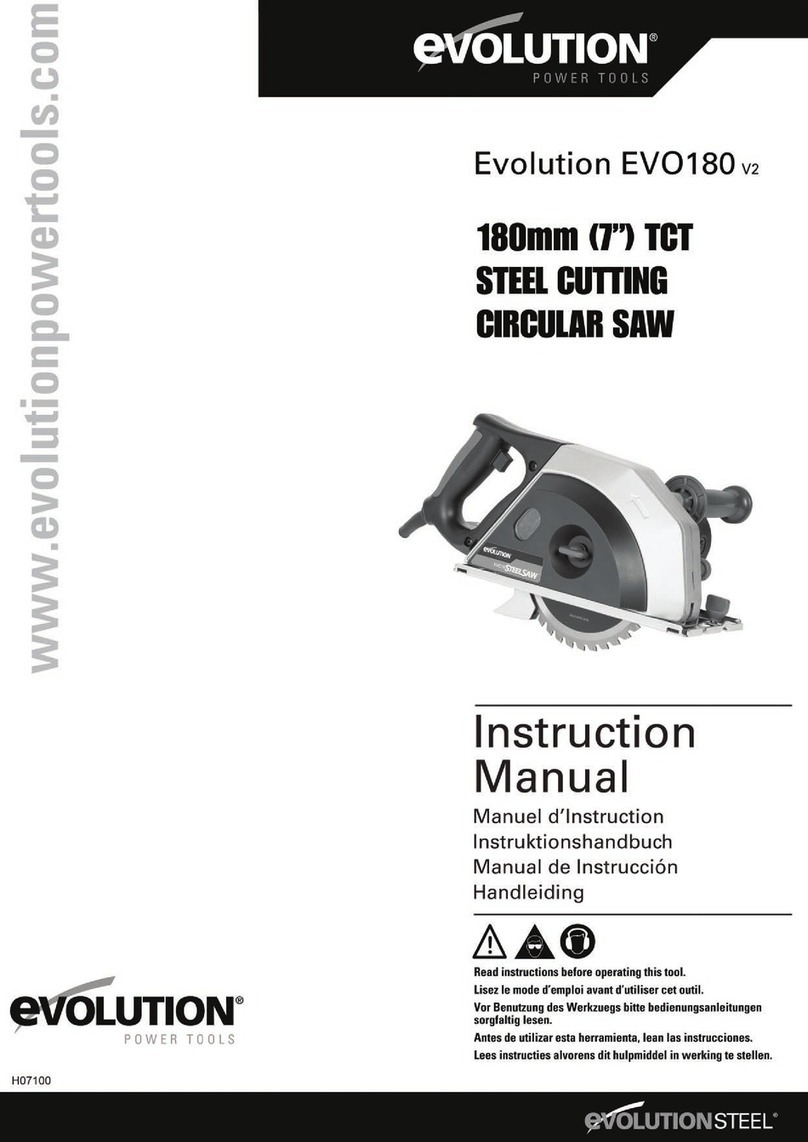
Evolution
Evolution EVO180 V2 instruction manual

Shindaiwa
Shindaiwa 490 Owner's/operator's manual
